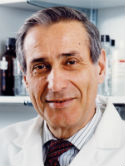| Abstract: |
This study was undertaken to identify a heparan sulfate (HS) degradation endoglycosidase (heparanase) in cultured endothelial cells (EC) and to characterize the requirements for its release and subsequent degradation of HS side chains in the subendothelial extracellular matrix (ECM). Intact EC, EC lysates, or EC conditioned media from different sources were incubated with metabolically Na235SO4‐labeled ECM produced by bovine EC. The released sulfated products were analyzed by gel filtration on Sepharose 6B. Human umbilical vein endothelial cells (HUVEC) and human saphenous vein endothelial cells (HSVEC) lysates expressed heparanase activity as indicated by release of most of the radioactivity from ECM as HS fragments that are one‐fifth to one‐sixth the size of the intact HS side chains. These fragments were sensitive to deamination with nitrous acid and were not produced in the presence of heparin. Rabbit coronary microvascular EC and bovine brain capillary EC lysates showed less heparanase activity (30–35%), whereas bovine aortic and corneal EC showed no activity. Intact HUVEC, piated directly on the labeled ECM, expressed low enzyme activity that was not changed when cells were exposed to various agents. Exposure of HUVEC to interleukin‐1, phorbol myristate acetate, tumor necrosis factor, endotoxin, thrombin, calcium ionophore A23187, fibroblast growth factor, or radiation did not induce release of the enzyme to the medium or degradation of HS in the ECM, as long as the cells remained viable. EC differ from various normal and malignant cells that degrade HS by virtue of their inability to release the enzyme. We suggest that heparanase release during vessel wall injury may regulate the growth of EC and smooth muscle by release of HS degradation products in processes such as wound healing, neovascularization, and atherosclerosis. Copyright © 1991 Wiley‐Liss, Inc. |




